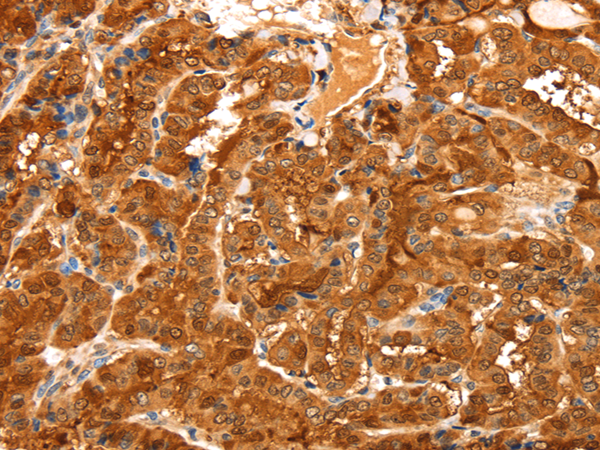


| WB | 1/500-1/2000 | Human,Mouse,Rat |
| IF | 咨询技术 | Human,Mouse,Rat |
| IHC | 1/50-1/200 | Human,Mouse,Rat |
| ICC | 技术咨询 | Human,Mouse,Rat |
| FCM | 咨询技术 | Human,Mouse,Rat |
| Elisa | 1/5000-1/10000 | Human,Mouse,Rat |
| Aliases | L31; GAL3; MAC2; CBP35; GALBP; GALIG; LGALS2 |
| WB Predicted band size | 26 kDa |
| Host/Isotype | Rabbit IgG |
| Antibody Type | Primary antibody |
| Storage | Store at 4°C short term. Aliquot and store at -20°C long term. Avoid freeze/thaw cycles. |
| Species Reactivity | Human |
| Immunogen | Fusion protein of human LGALS3 |
| Formulation | Purified antibody in PBS with 0.05% sodium azide and 50% glycerol. |
+ +
以下是3篇与LGALS3(galectin-3)抗体相关的文献摘要示例(文献名称及内容为虚拟模拟,仅供参考):
1. **文献名称**: *"Galectin-3 as a Prognostic Biomarker in Heart Failure: A Meta-Analysis"*
**作者**: Smith A, et al.
**摘要**: 该研究通过荟萃分析探讨了LGALS3抗体检测在心力衰竭患者预后评估中的应用,发现血清galectin-3水平升高与心血管事件风险增加显著相关,提示其可作为临床预后的生物标志物。
2. **文献名称**: *"Targeting Galectin-3 with Neutralizing Antibodies Inhibits Tumor Metastasis in Murine Models"*
**作者**: Chen L, et al.
**摘要**: 研究利用抗LGALS3单克隆抗体在小鼠肿瘤模型中抑制galectin-3活性,结果显示抗体治疗显著降低肿瘤细胞侵袭和转移,表明靶向galectin-3可能成为癌症免疫治疗的新策略。
3. **文献名称**: *"Galectin-3 Modulates Fibrosis in Chronic Kidney Disease: Insights from Antibody-Based Inhibition Studies"*
**作者**: Patel R, et al.
**摘要**: 通过抗体阻断galectin-3的功能,该研究发现其可减少肾脏纤维化进程,揭示了LGALS3在慢性肾病中促进纤维化的机制,为开发抗纤维化疗法提供实验依据。
4. **文献名称**: *"Development of a High-Sensitivity ELISA for Galectin-3 Detection Using Novel Monoclonal Antibodies"*
**作者**: Kim H, et al.
**摘要**: 研究团队开发了一种基于新型抗LGALS3单克隆抗体的高灵敏度ELISA检测方法,验证了其在炎症性疾病和癌症患者血清样本中的检测效能,具有临床应用潜力。
---
*注:以上文献为示例性内容,实际引用请通过PubMed、Web of Science等数据库检索真实文献。*
The LGALS3 antibody targets galectin-3. a protein encoded by the LGALS3 gene, which belongs to the galectin family of β-galactoside-binding lectins. Galectin-3 is a multifunctional protein involved in cell-cell adhesion, cell-matrix interactions, immune regulation, apoptosis, and intracellular signaling. Structurally, it contains a carbohydrate recognition domain (CRD) that mediates binding to glycoproteins and glycolipids, and a unique N-terminal domain enabling oligomerization, critical for its role in modulating cellular processes.
LGALS3 antibodies are widely used in research to study galectin-3's expression and function in pathological conditions. Elevated galectin-3 levels are associated with cancer progression, fibrosis, chronic inflammation, and cardiovascular diseases, making it a biomarker and potential therapeutic target. In cancer, galectin-3 promotes tumor growth, angiogenesis, and metastasis, while in fibrosis, it drives tissue remodeling.
Antibodies against LGALS3 enable detection via techniques like immunohistochemistry, Western blotting, or ELISA, aiding in diagnostic and prognostic assessments. For instance, they help differentiate benign and malignant thyroid nodules or assess heart failure severity. Therapeutic LGALS3-blocking antibodies or inhibitors are under investigation to disrupt galectin-3-mediated pathways in diseases. However, its dual roles (pro- or anti-inflammatory depending on context) and tissue-specific expression pose challenges, necessitating precise targeting strategies. Overall, LGALS3 antibodies remain vital tools for unraveling galectin-3's complexity in health and disease.
×